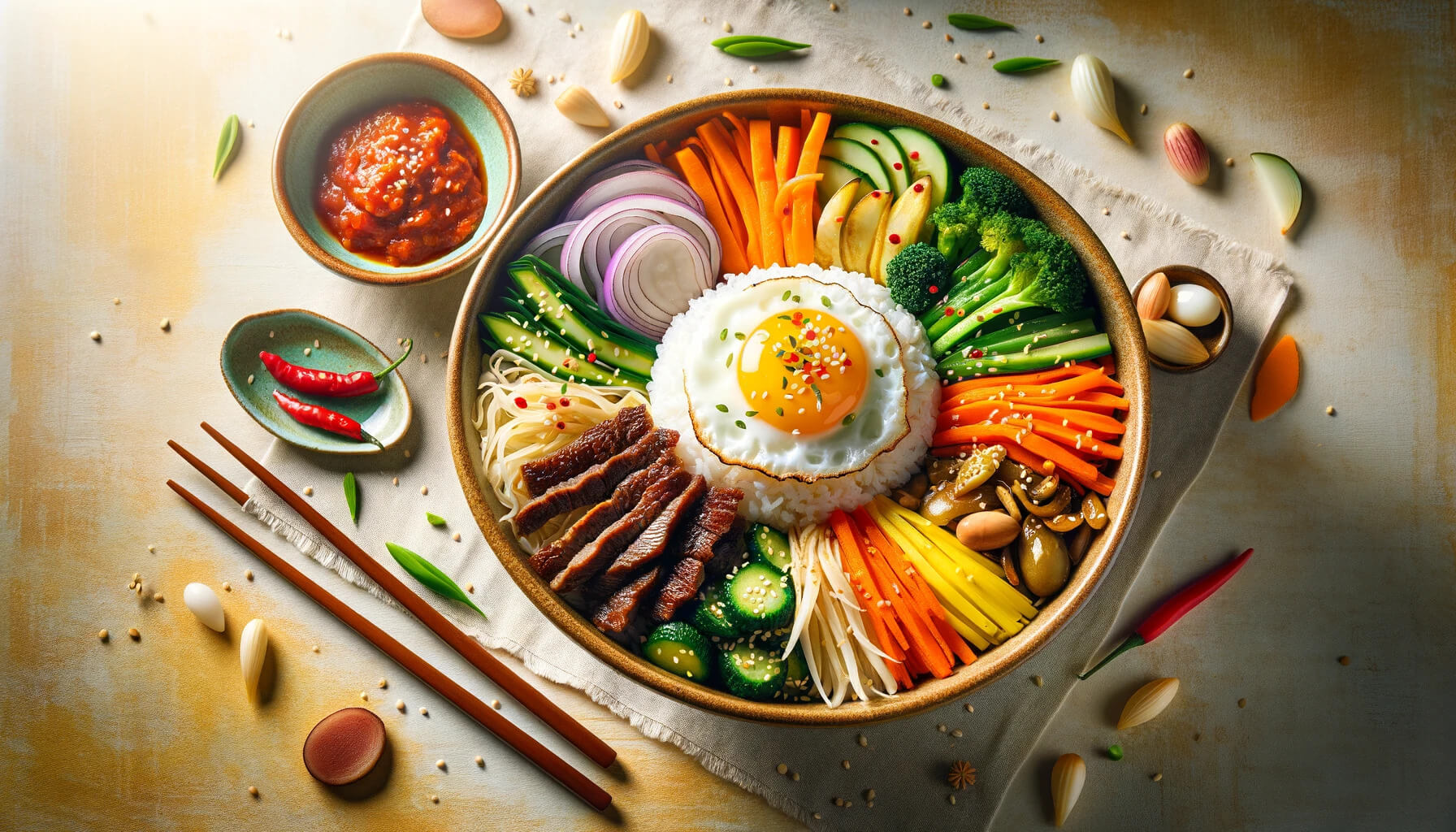Bibimbap

Ingredients
For the Rice and Toppings:
- 2 cups white rice
- ½ lb beef
- Spinach
- Bean sprouts
- 1 zucchini
- 1 carrot
- Shiitake mushrooms
- 4 eggs
For the Seasoning:
- Gochujang
- Sesame oil
- Sesame seeds
- Salt and pepper
Instructions
Prepare the Rice: Cook the white rice according to package instructions and keep it warm.
Cook the Vegetables: Sauté or blanch the spinach, bean sprouts, zucchini, carrot, and mushrooms with a bit of salt and sesame oil until tender but still vibrant.
Prepare the Beef: Marinate the beef slices in a mixture of soy sauce, sesame oil, garlic, and sugar. Cook in a hot pan until browned and set aside.
Assemble the Bibimbap: In a bowl, place a serving of warm rice and arrange the cooked vegetables, beef, and a fried egg on top. Add a dollop of gochujang and sprinkle with sesame seeds.
Serve: Before eating, mix all the ingredients together, adding additional sesame oil and gochujang to taste. Enjoy the harmonious blend of flavors and textures in each bite.
A Kaleidoscope of Korean Flavors
Embark on a culinary adventure with Bibimbap, a dish that perfectly captures the essence of Korean cuisine through its diversity of ingredients and flavors. This recipe walks you through the simple yet satisfying process of creating a Bibimbap that’s as authentic as it is delicious. Whether enjoyed as a special weeknight dinner or a way to impress guests, Bibimbap is a testament to the beauty of Korean food, inviting everyone to explore its rich culinary landscape.
Personal Touches and Variations
- Vegetarian Options: Easily adapt Bibimbap to a vegetarian or vegan diet by substituting the beef with tofu or just increasing the variety of vegetables.
- Customize Your Heat: The amount of gochujang can be adjusted according to your spice preference, making it a versatile dish that can cater to everyone’s taste.
- A Bowl Full of History: Bibimbap has its roots in royal Korean cuisine, evolving over time into a beloved dish enjoyed by people from all walks of life. Its preparation and communal consumption highlight the importance of balance and harmony in Korean culture, both in food and in life.
The Art of Mixing
Bibimbap is more than just a dish; it’s a ritual. The act of mixing all the ingredients together before eating is not only practical but symbolic, representing the harmony of different elements coming together to create something greater than the sum of its parts. Each ingredient in Bibimbap has its place, but it’s the act of mixing that truly brings out the depth of flavors and textures, offering a new experience with each bite.
Seasonal Adaptations
One of the beauties of Bibimbap is its adaptability to seasons. In spring, incorporate fresh greens and wild vegetables; summer calls for light and refreshing ingredients like cucumber and radish; in autumn, mushrooms and root vegetables take center stage; while winter is perfect for hearty ingredients like kimchi and spinach. This seasonal rotation not only makes Bibimbap a year-round delight but also a canvas for showcasing the best of what’s available.
A Cultural Experience
Enjoying Bibimbap is an immersive experience into Korean culture, reflecting the country’s agricultural roots and the importance of communal eating. It’s a dish that tells stories of the past while being firmly rooted in the present, adaptable to modern tastes and dietary preferences. Preparing and sharing Bibimbap can be a meaningful way to connect with friends and family, inviting them to explore the rich tapestry of Korean cuisine and the values it embodies.
Mindful Eating
Bibimbap encourages a mindful approach to eating. As you mix the ingredients, take a moment to appreciate the colors, textures, and aromas before you. Eating Bibimbap can be a meditative experience, reminding us to slow down and savor the moment, enjoying the nourishment it provides not just for the body but also for the soul.
Nutrition Facts
- Serving Size: 1 bowl
- Servings Per Recipe: 4
- Calories: 600
% Daily Value
- Total Fat: 20gg (26% DV)
- Saturated Fat: 5gg (25% DV)
- Cholesterol: 190mgmg (63% DV)
- Sodium: 300mgmg (13% DV)
- Total Carbohydrates: 80gg (29% DV)
- Dietary Fiber: 5gg (18% DV)
- Total Sugars: 5gg
- Protein: 25gg
Note: The “% Daily Value” (DV) tells you how much a nutrient in a serving of food contributes to a daily diet. 2,000 calories a day is used for general nutrition advice.
Recipe analyzed by verywell.
